 Weird Stuff
Weird Stuff  Weird Stuff
Weird Stuff  Health
Health Ten Confounding New Inventions from the World of Biomedicine
 Creepy
Creepy 10 Death Superstitions That Will Give You the Creeps
 Movies and TV
Movies and TV 10 Movies That Get Elite Jobs Right, According to Experts
 Weird Stuff
Weird Stuff 10 Times Real Laws Were Based on Bizarre Hypotheticals
 Animals
Animals 10 Inspiring Tales of Horses Being Human
 Mysteries
Mysteries Top 10 Haunting Facts About the Ghost Ship MV Alta
 History
History 10 Surprising Stories About the Texas Rangers
 Humans
Humans 10 Philosophers Who Were Driven Mad by Their Own Theories
 Miscellaneous
Miscellaneous 10 Video-Game-Worthy Weapons and Armors from History
 Weird Stuff
Weird Stuff 10 Warning Labels That Exist Because Someone Actually Tried It
 Health
Health Ten Confounding New Inventions from the World of Biomedicine
 Creepy
Creepy 10 Death Superstitions That Will Give You the Creeps
Who's Behind Listverse?

Jamie Frater
Head Editor
Jamie founded Listverse due to an insatiable desire to share fascinating, obscure, and bizarre facts. He has been a guest speaker on numerous national radio and television stations and is a five time published author.
More About Us Movies and TV
Movies and TV 10 Movies That Get Elite Jobs Right, According to Experts
 Weird Stuff
Weird Stuff 10 Times Real Laws Were Based on Bizarre Hypotheticals
 Animals
Animals 10 Inspiring Tales of Horses Being Human
 Mysteries
Mysteries Top 10 Haunting Facts About the Ghost Ship MV Alta
 History
History 10 Surprising Stories About the Texas Rangers
 Humans
Humans 10 Philosophers Who Were Driven Mad by Their Own Theories
 Miscellaneous
Miscellaneous 10 Video-Game-Worthy Weapons and Armors from History
People Famous For Doing Things They Didn’t Do
Stories of the great inventors and innovators of previous generations have been passed down through the ages. People love to hear a good tale, and the best ones always feature the most brilliant, incredible person doing something inconceivably great or virtuous.
Whether it involves discovering a new part of the world, inventing a new technology, or making a rebellious statement in the face of injustice, our heroes are always the infallible best that their generations have to offer—or so we often believe.
In actuality, many of those great stories are subject to changes and embellishments over the years. By the time we hear them in the modern day, they are either full of misconceptions or even downright false.
10 Pythagoras Did Not Discover The Pythagorean Theorem
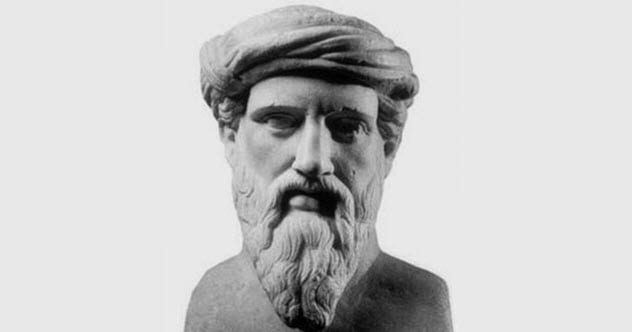
Anyone who has ever taken a geometry class has probably had the Pythagorean Theorem drilled into their memory. This theorem states that for any right angle triangle, the square of the hypotenuse, the longest side, is equal to the sum of the squares of the other two sides.
It is a valuable tool used for bridge building, construction, or even just determining the distance between two points. Yet this well-known theorem was not actually discovered by the famous philosopher after which it was named.
Born circa 569 BC, Pythagoras was a Greek mathematician, but most of what is known about him was recorded by historians who lived hundreds of years after he died. Although he is believed to be the first mathematician, his actual contributions to the field of mathematics are largely unknown.
He is thought to have founded a school, the Semicircle of Pythagoras, that walked the fence between science and religion. It focused on intellectual pursuits as well as an understanding of the divine meaning behind numbers. The school practiced collectivism, meaning any discoveries made by any member were attributed to Pythagoras, possibly including the Pythagorean Theorem.
Furthermore, a clay tablet originating from the Old Babylonian period shows that the Babylonians already knew the mathematical relationship between the diagonal of a square and its side, a special case of the Pythagorean Theorem, somewhere between 1800 BC and 1600 BC. This was over 1,000 years before Pythagoras was born.[1]
9 Michael Jackson Did Not Invent The Moonwalk
While performing his famous hit “Billie Jean” for the Motown 25th anniversary live show in 1983, the King of Pop performed what would forever become his signature dance move—the moonwalk. This famous move, in which the dancer appears to be walking forward while simultaneously gliding backward, became associated with Michael Jackson from that day forward.
However, although Jackson certainly made the move famous, he did not invent it. Performers had been using it in their acts for many years prior.
Originally known as the backslide, this move was previously used by African-American tap dancer Bill Bailey in his dance act way back in the 1950s. Famous mimes, including Marcel Marceau, also used the move in their routines, and stars like James Brown and Bill Robinson did it years before Jackson.
In fact, Jackson had learned it from two young dancers, Casper Candidate and Cooley Jaxson, who had performed the move in their Boogaloo act featured on Soul Train back in the 1970s. Although the King of Pop certainly deserves recognition for bringing the moonwalk to the masses, this iconic move was first performed long before Jackson was even a twinkle in his wicked father’s eye.[2]
8 Alexander Fleming Was Not The First To Discover The Antibiotic Properties Of Mold
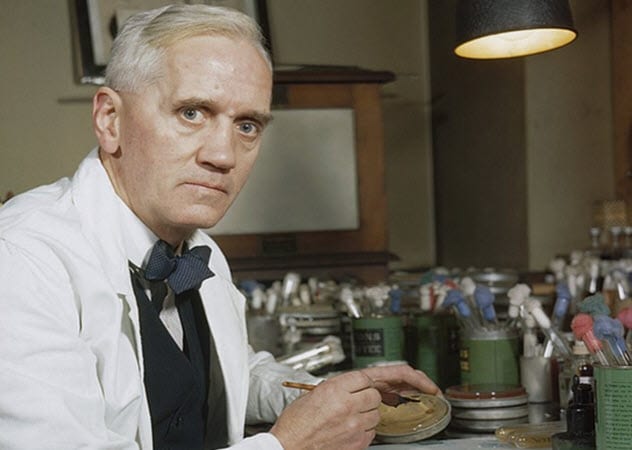
As antibiotic resistance rears its head in our modern society and makes even seemingly small bacterial infections deadly, we should take a moment to acknowledge how our antibiotic journey began. As the story goes, the first antibiotic was discovered accidentally in 1928 by Sir Alexander Fleming, a scientist who was studying the influenza virus at the time.
Sir Fleming noticed that a plate of Staphylococcus bacteria he had been growing had been contaminated by mold and that the mold had left a circle around it in which no bacteria would grow. In later tests, he diluted the mold culture 800 times and found that it was still an effective antibacterial agent.
Naming the active substance penicillin after the mold from which it was derived (Penicillium), Sir Fleming’s discovery prevented an uncountable number of deaths in the years to come.
While Sir Fleming’s incredible work should never be discredited, there is another lesser-known scientist who researched the antibacterial properties of mold years earlier. Vincenzo Tiberio was an Italian scientist born in 1869 in Sepino.
While studying medicine in Naples, Tiberio lived in an old house that relied on a well for water. He noticed that whenever the well was cleaned to remove the mold on the inner walls, the people who drank from the well suffered from intestinal maladies that did not stop until the mold had regrown.[3]
After some further research, Tiberio concluded that certain molds, including Penicillium, had antibacterial effects. However, his discovery was disregarded as coincidence by the scientific world and was essentially ignored.
7 Thomas Edison Did Not Invent The Light Bulb
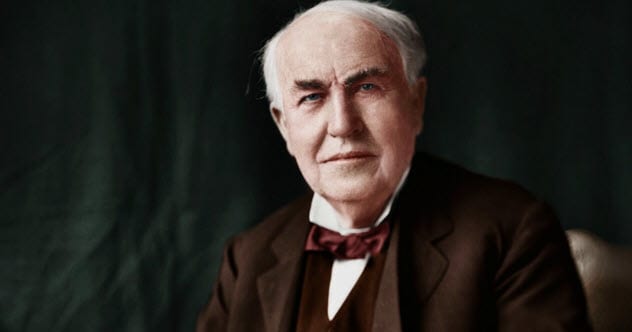
Thomas Edison is a well-known inventor. But among other inventors of his time, he was probably better known for the massive number of patents he owned—1,093, to be exact. Edison is known to have been a creator not only of innovative technologies but also of myths surrounding himself.
He often boasted that he could get by on only three hours of sleep a night and that he had never had a formal education, both of which were proven to be exaggerated claims. Arguably, the best-known myth surrounding Edison is that he invented the light bulb.
In 1800, Italian inventor Alessandro Volta developed the voltaic pile, a contraption consisting of alternating discs of copper and zinc interspersed with cardboard soaked in salty water. The voltaic pile conducted electricity when copper wire was attached at either end, and the wire would begin to glow.[4]
In 1802, Humphry Davy found a way to connect voltaic piles and charcoal electrodes, producing the first electric lamp. Davy’s lamp was imperfect—it was overly bright and burned out quickly.
Years later in 1840, Warren de la Rue developed a more efficient light bulb using coiled platinum, but the price of platinum made it costly. English chemist Joseph Swan improved the design in 1860 by using much cheaper carbonized paper filaments in place of the platinum coils.
In 1879, Edison finally entered the fray, replacing the filament in Swan’s bulb with a filament of high electrical resistance. Edison’s bulb was the most effective and cost-efficient at the time, but it certainly was not the first to exist and not his original idea. If anything, the light bulbs we so rely on today arose from a massive group effort spanning many years. They were not the work of any one man or woman.
6 Christopher Columbus Did Not Discover That The Earth Was Round
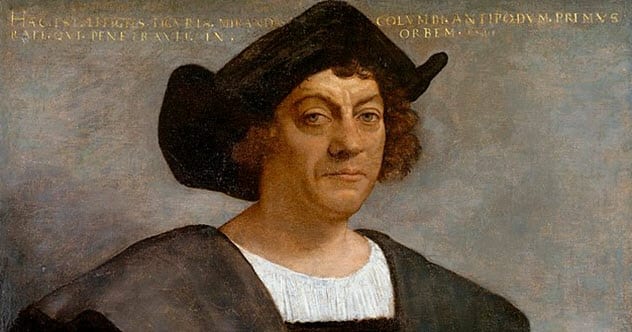
To this day, a belief persists that Christopher Columbus bravely sailed west on his journey to Asia, fearlessly risking falling off the side of the map to prove that the Earth was round and not a finite plane.
But this is not true. Although Columbus set sail in the 1490s, people had already known that the Earth was round since 600 BC thanks to the work of Aristotle and other scientists of that time.
The myth surrounding Columbus originates from a book written in 1828 by author Washington Irving. He added some artistic license to his retelling of Columbus’s journey. Irving claimed that Columbus was called a fool and had his faith questioned by Catholic geographers who thought that his idea of a round Earth was preposterous.
In reality, the challenges faced by Columbus had nothing to do with the shape of the Earth. Instead, its circumference was the problem. Columbus believed that the circumference of the Earth was small enough that he could sail west instead of east to reach Asia and establish a new trade route.[5]
It must have been quite a shock when he instead discovered the Americas (at least for the Europeans—indigenous people had already lived there for thousands of years).
5 Eve Did Not Eat An Apple In The Book Of Genesis

As the famous Bible story goes, the first sin committed by humans came in the form of Eve disobeying God and eating an apple from the tree of the knowledge of good and evil . . . but did she really?
From arguably one of the most famous Bible stories, one common misconception seems to be prevalent in most versions of the story that exist outside of the Bible verse—that is, the belief that the forbidden fruit was an apple.
Apples are never actually mentioned in the Garden of Eden. In Genesis 1:27–29, God tells Adam and Eve that they can eat any fruit that has seeds, which includes apples. The forbidden fruit that Eve eats is never described in detail, though the misconception of it being an apple may arise from a mistranslation.[6]
The Vulgate, or Latin translation of the Bible, uses the word mali for “evil” when describing the tree. The word for “apple” is the very similar-sounding mala. Whatever the case, it seems that the only true bad apple in the Book of Genesis was Eve’s future son, Cain, who would go on to murder his brother over some vegetables. But that is a story for a different list.
4 George Washington Did Not Chop Down A Cherry Tree
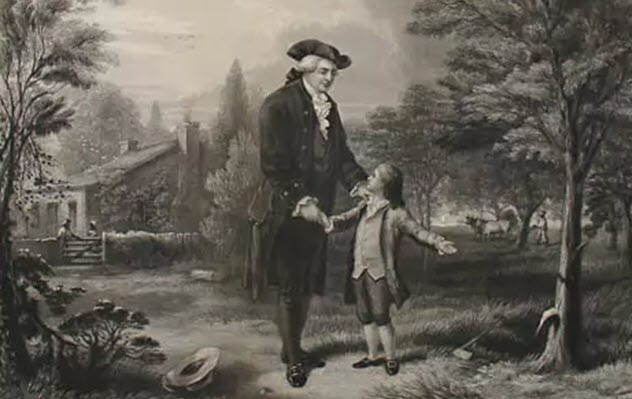
George Washington is often portrayed as a man of great virtue and valor—and for very good reason. In short, he was such a man. Washington was not only the commander of the Continental Army who brought his country to victory in the American Revolution but he also served as the first president of the United States.
He worked tirelessly to establish the newly independent country after it was freed from British rule as well as to initiate religious freedom for all Americans. He was a remarkable man for sure. But for some authors, his life story still needed just a little more pizzazz.
After Washington died in 1799, Mason Locke Weems, one of his first biographers, decided that the story of Washington’s life needed some enhancements. To paraphrase Weems, he believed that Washington’s biography should show that his rise to the top was a result of his virtuous nature.
To this day, little is known about Washington’s childhood, but the tale created by Weems to show young Washington’s propensity for honesty still lives on. In the story, six-year-old George receives a new hatchet, which he promptly uses on one of his father’s cherry trees.[7]
When his father discovers the damage, he confronts his son, only to have George bravely admit what he did without hesitation because he “cannot tell a lie.” Although ironically a lie about the importance of honesty, this cherry tree myth has been passed down for so many generations that it is still widely featured in political cartoons and the like.
3 Julius Caesar Was Never The Emperor Of Rome
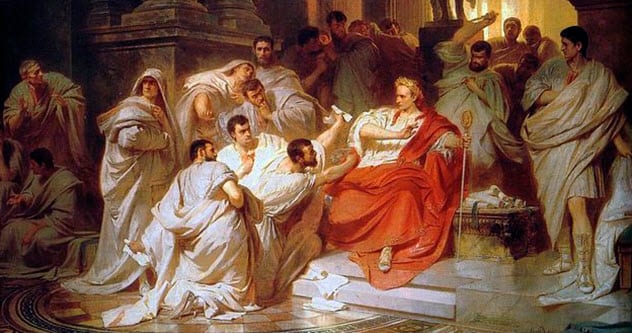
An affair with Cleopatra, a secret love child, and a run-in with pirates who tried to ransom him for far less than he believed he was worth—no one can claim that Julius Caesar did not lead a full and exciting life. Still, even the once-great leader of Rome has fallen victim to some widely believed misconceptions over the years.
Gaius Julius Caesar, more commonly known as Julius Caesar, was born during a time of instability in the Roman Republic. After losing his father as a young man, Caesar quickly drew the ire of the Roman dictator, Sulla. He posed enough of a threat to Caesar’s life that Caesar joined the military to try to avoid death.
By the time he turned 31, Caesar had fought in multiple wars and started to involve himself in politics. Eventually, he worked his way up the ladder to become dictator of the Roman Empire. He was a legendary general, a master of politics, and a champion for the lower-class citizens of Rome. But there is one title that Caesar never earned in his lifetime—Emperor.
While often credited incorrectly as the first Roman emperor, Caesar was never an emperor at all. The year before his death, Caesar declared himself dictator-for-life, a position that did not sit well with everyone. Members of the Roman Senate reacted poorly, thinking that Caesar was building himself up to eventually become king.[8]
The Romans had no desire for a monarch, having lived without one for an estimated five centuries by the time Caesar came along. He was assassinated on the Ides of March, or March 15, to prevent his ascension to that position.
Julius’s adopted son, Gaius Octavius Thurinus, better known as Augustus, took over his adoptive father’s position after Julius’s murder. Eventually, Augustus became the first emperor of Rome, although even he never actually used the title himself. Et tu, Augustus?
2 Hamlet Was Not An Original Idea From William Shakespeare
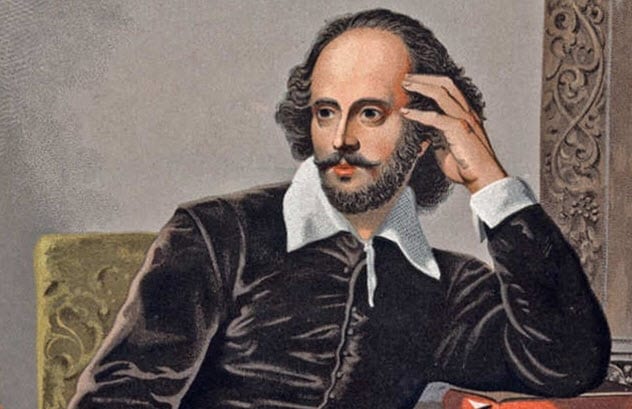
The melancholy tragedy of Hamlet is arguably one of the best-known works by William Shakespeare, but it may surprise you to know that he did not invent the plot himself. Shakespeare’s Hamlet was heavily influenced by a Norse legend written by Danish historian Saxo Grammaticus.
In fact, even the name of Grammaticus’s protagonist, Amleth, is an anagram of Hamlet. However, whether that was intentional or a mistake made in translation is unclear.
In both Hamlet and the story of Amleth, there exists an uncle who murders the king, takes the throne, marries his brother’s widow, and plots to kill his nephew, who pretends to be mentally unstable to avoid his uncle’s wrath. The uncles in both stories try to target their nephew first by using a young woman to lure him, then by planting a spy on him, and finally by employing two escorts to take the prince to England to be killed there.
At the end of both stories, the uncle is killed by his nephew as revenge, though Amleth survives and Hamlet dies in their respective works. Clearly, the similarities between the stories are more than coincidence.
It is also a possibility that Shakespeare did not base his plot on Grammaticus’s work directly, but rather on another play called the Ur-Hamlet. Written by Thomas Kyd, the Ur-Hamlet was known to be heavily based on Grammaticus’s legend of Amleth.[9]
No surviving copy of the Ur-Hamlet exists to compare to Shakespeare’s work. All that is known about this play is that it was a tragedy, contained a character named Hamlet, and had a ghost who spoke to Hamlet about revenge. All of this exists in Shakespeare’s work as well.
Adapting a story or being influenced by another author is not unheard of or even uncommon, and Shakespeare is responsible for making the tale of Hamlet/Amleth so famous. Still, credit for the plot behind this story should be given where it is due, and that appears to be to Grammaticus.
1 Joseph-Ignace Guillotin Did Not Invent The Guillotine
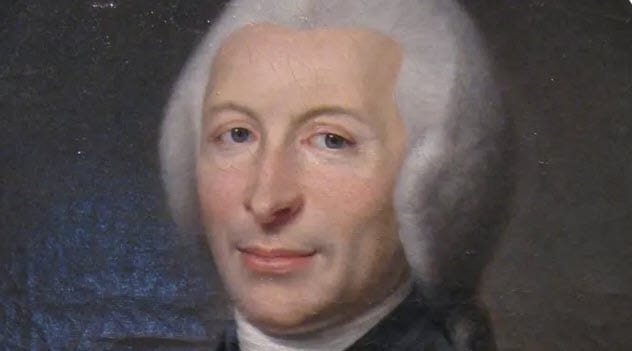
As misleading as the name may be, French doctor Joseph-Ignace Guillotin did not invent the guillotine. Ironically, he was a strong opponent of capital punishment.
In 1789, with state executions in France mostly consisting of gory axe beheadings or hanging deaths, Guillotin proposed to the French National Assembly that a more humane method of killing be adopted. This call was answered by surgeon Antoine Louis. He drafted the first design of the killing machine based on similar ones that existed in Scotland and Italy.
The first prototype was then created by a German named Tobias Schmidt and was put to use in future executions. Though Guillotin played no role in its design or construction, this instrument of death became known as the guillotine after Joseph’s surname due to his staunch defense of humane capital punishment.[10]
Had it gone any other way, however, this infamous device may have become known as the Louis or the Schmidt, neither of which have quite the same ring to them.
Read about more famous people who are nothing like you think on 10 Famous People Who Are Nothing Like You Imagined In Real Life and 10 Famous People With Surprising Achievements.








